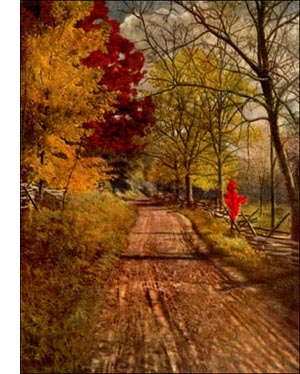Western Juniper Tree
 Western juniper (Juniperus occidentalis, Hook.)-Low, broad-headed tree, 20 to 65 feet high, with unusually thick trunk and stout, horizontal branches. Bark > inch thick, bright crimsonred, in broad, scaly ridges, with shallow irregular interlacing furrows. Wood soft, light, pale reddish brown, fine grained, very durable in the soil. Leaves in threes, minute, closely appressed to twigs, grey-green, tapering, sharp pointed. Flowers cone-like, monoecious, inconspicuous. Fruit a blue-black berry with pale bloom, I to 3 inch long; seeds 2 to 3. Preferred habitat, mountain sides and elevated plains, 6,000 to 10,000 feet. Distribution, western Idaho, Washington, Oregon and California, following the Sierra Nevada Mountains to the San Bernardino range. Uses: Wood for fencing and fuel. Bark woven into mats and cloth by Indians. Fruit an important article of food among California tribes.
Western juniper (Juniperus occidentalis, Hook.)-Low, broad-headed tree, 20 to 65 feet high, with unusually thick trunk and stout, horizontal branches. Bark > inch thick, bright crimsonred, in broad, scaly ridges, with shallow irregular interlacing furrows. Wood soft, light, pale reddish brown, fine grained, very durable in the soil. Leaves in threes, minute, closely appressed to twigs, grey-green, tapering, sharp pointed. Flowers cone-like, monoecious, inconspicuous. Fruit a blue-black berry with pale bloom, I to 3 inch long; seeds 2 to 3. Preferred habitat, mountain sides and elevated plains, 6,000 to 10,000 feet. Distribution, western Idaho, Washington, Oregon and California, following the Sierra Nevada Mountains to the San Bernardino range. Uses: Wood for fencing and fuel. Bark woven into mats and cloth by Indians. Fruit an important article of food among California tribes.Here is one of the patriarchal trees of America-one whose age ranks it with the Sequoias, dating the birth of the oldest back, assuredly, more than 2,000 years. It is impossible to find a giant with trunk sound to the core and telling the whole story in its annual rings. John Muir is probably the only man who has made serious inquiry into this matter. On the bleak ridges of the Sierras, with no soil but crumbs of disintegrating granite, these trees make scarcely any gain from year to year. Two of Muir's measurements are given below, the years being determined by the number of annual rings.
Diameter of Trunk 2 feet 11 inches ............ Age 1,140 years
Diameter of Trunk 1 foot 7 1/2 inches ........ Age 834 years
Being a poet as well as a scientist, John Muir was deterred from the killing of one of the elders, merely to appease his curiosity. Beside, dry rot and scars of ancient hurts confuse the reader of tree rings, and throw him upon estimates, after all. The difficulties of chopping down a tree 10 feet in diameter would discourage the most ardent searcher after treasures of fact hid in a tree trunk.
A chip a foot deep chopped out of a medium-sized tree-6 feet in diameter-showed an average of fifty-seven years of growth required to make an inch of wood. On soil deposited in the high valleys by glacial rivers these junipers grow about as fast as oaks. They are the well-fed, commonplace members of the family, growing tall and straight under favouring skies.
I cannot forbear a quotation from John Muir's "Forests of the Yosemite Park," for he knows these mountain trees person
ally, and has interpreted them to the world as no other man has done:
"The sturdy storm-enduring red cedar (Juniperus occidentalis) delights to dwell on the tops of granite domes and ridges and glacier pavements of the upper pine belt, at an elevation of 7,000 to 10,000 feet, where it can get plenty of sunshine and snow and elbow room, without encountering quick-growing, overshadowing rivals. They never make anything like a forest, seldom come together even in groves, but stand out separate and independent in the wind, clinging by slight joints to the rock, living chiefly on snow and thin air, and maintaining tough health on this diet for 2,000 years or more, every feature and gesture expressing steadfast, dogged endurance. ... Many are mere stumps as broad as high, broken by avalanches and lightning, picturesquely tufted with dense grey scale-like foliage, and giving no hint of dying. . . Barring accidents, for all I can see, they would live forever. When killed, they waste out of existence about as slowly as granite. Even when overthrown by avalanches, after standing so long, they refuse to lie at rest, leaning stubbornly on their big elbows as if anxious to rise, and while a single root holds to the rocks, putting forth fresh leaves with a grim never-say-die and never-lie-down expression."